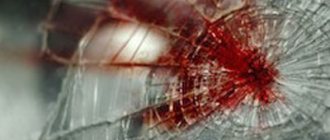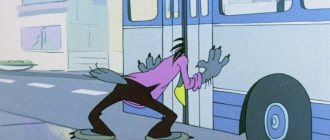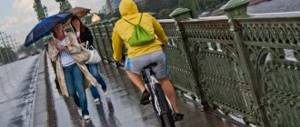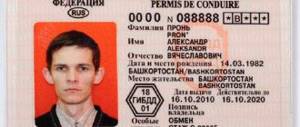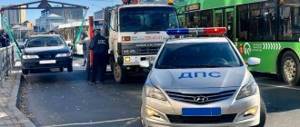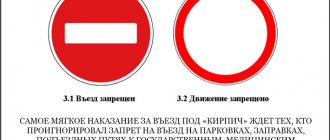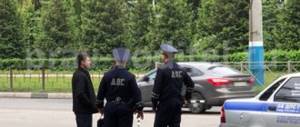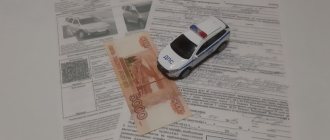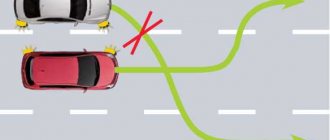Moscow, 05/26/2021, 15:03:36, editorial office PRONEDRA.RU, author Ekaterina Litvinchik.
In order to regulate the relationship between pedestrians and road users in vehicles, a number of new standards have been developed to reduce the number of deaths on the roads. Many driving instructors, when training drivers, always insist that a pedestrian on the road always has certain advantages and must be allowed to pass. In fact, this is not a completely correct interpretation of the laws that are in force in the country now.
Fine for not allowing a pedestrian to pass in 2021
Let's consider article 12.18 of the Administrative Code:
Article 12.18. Failure to give priority in traffic to pedestrians or other road users
Failure to comply with the requirement of the Traffic Rules to give way to pedestrians, cyclists or other road users (except for vehicle drivers) who have priority in traffic, -
shall entail the imposition of an administrative fine in the amount of one thousand five hundred to two thousand five hundred.
In 2021, the fine is 1500 - 2500 rubles .
The selection of a fine in the specified range is made by a traffic police officer. In doing so, he must take into account mitigating and aggravating circumstances. Thus, if the driver committed a violation for the first time, then, as before, he will receive a minimum fine of 1,500 rubles.
In addition, I suggest you download and print the current table of fines:
Traffic police fine table
Changing lanes at a pedestrian crossing: traffic rules
To give a clear answer to the question of whether it is possible to change lanes at a zebra crossing, you must first remember the basic terms associated with performing such a maneuver.
Did you know? In India, cows have the absolute advantage of crossing the roadway - car drivers are required to let them pass under any conditions, since this animal is considered sacred.
Changing lanes is when a car leaves the lane it occupies on the road while maintaining its original direction of movement, i.e. this maneuver involves changing the current lane. Typically, drivers change lanes to make a turn or overtake another vehicle that is moving in the same direction as them on the same roadway.
A pedestrian crossing is a section of the roadway that is specially equipped for the movement of pedestrians. It is usually marked with standard asphalt markings or road signs, and may also have a traffic light.
The new traffic rules do not prohibit the maneuver of changing lanes in the area of a pedestrian crossing, i.e., by default they allow drivers to perform such an action. But in some cases it can lead to violations of other rules or create an emergency situation on the road. For example, some drivers confuse changing lanes with overtaking, which involves driving the car into the lane of oncoming traffic.
If a motorist decides to change lanes at a zebra crossing, he needs to perform the following mandatory actions:
- reduce driving speed;
- turn on the turn signal (even if there are apparently no other cars or pedestrians on the road);
- adequately assess the speed and trajectory of movement of other cars and pedestrians, and also take into account the distance to them;
- make sure that there is no continuous line on the road or other obstacles for changing lanes;
- carry out the maneuver at medium speed, without slowing down or accelerating.
Important! According to traffic rules, cars are not prohibited from moving in 2 rows within the boundaries of one marked lane, therefore in such a situation, leaving the current row within the same lane is also considered changing lanes.
Read more about changing lanes at an unregulated and controlled pedestrian crossing later in the article.
Video: car rebuild technique
Unregulated pedestrian crossing
Unregulated pedestrian crossings are usually found on narrow streets with little traffic flow and are characterized by special markings on the roadway, and warning and restrictive signs for motorists are installed near them.
The following characteristic elements may be present in such an area:
- traffic light in flashing yellow mode;
- markings on the asphalt surface of the road, consisting of alternating stripes of white and orange colors;
- reflective edging of a road sign notifying motorists of the presence of a zebra crossing;
- bright light sources at night;
- a duplicate sign indicating the presence of a pedestrian crossing, placed above the traffic lane;
- flashing yellow lights;
- an artificially created small hill on the road, forcing the driver to reduce driving speed (“speed bump”);
- several noise stripes on the surface of the roadway - the interval between them decreases as the distance to the site decreases.
Changing lanes at an unregulated pedestrian crossing is not prohibited.
But for personal safety and in order to avoid a fine, the driver must follow several rules described in the traffic rules when performing such a maneuver:
- before such a section, the driver is required to slow down his car and exercise increased caution;
- if there are pedestrians on the zebra crossing, then all cars must stop;
- even if pedestrians have just entered the roadway (tram tracks) in the area of an unregulated crossing, the motorist must smoothly stop the car and let them pass;
- when crossing such a section, the driver is prohibited from driving into oncoming traffic, reversing or stopping directly at a zebra crossing;
- The driver of the car must slow down or stop completely if cars moving in the same direction with him have done one of these actions before an unregulated crossing.
Recommended reading:
- Where is a turn allowed, rules for performing the maneuver
- Is it possible to park in a semicircle?
- Driving with a trailer in a car
- What is the intersection of roadways at an intersection?
- Passing a bus according to traffic rules
At an unregulated pedestrian crossing, a motorist is forced to simultaneously take into account many factors, so his attention is scattered on pedestrians, road signs, assessing the speed and trajectory of other cars. To reduce the risk of an accident, it is not recommended to change lanes in such a section.
Video: unregulated pedestrian crossing
Adjustable pedestrian crossing
The main feature of a controlled pedestrian crossing is a properly functioning traffic light that switches light signals as normal. Such areas are usually developed at intersections or wide streets with a large flow of cars and pedestrians. In this case, the traffic light can operate “automatically” or be switched manually using a special button provided for a pedestrian to stop a continuous flow of traffic.
When a traffic light breaks down, a traffic controller must regulate the movement of cars and people in such busy areas. According to current traffic regulations, a motorist is not prohibited from changing lanes at a controlled pedestrian crossing.
Important! Regardless of the presence of a traffic light and the color it shows, the driver is prohibited from entering a zebra crossing if there is a traffic jam of other cars immediately behind it.
But when performing such a maneuver, the driver of the car must adhere to a number of rules:
- driving through such a zebra crossing is only permitted when the traffic light is green;
- if people started moving through the crossing at a green pedestrian traffic light, but did not have time to cross the section before the red light turned on, then the driver needs to give way to them so that they complete their movement path properly;
- if, during a lane change, the trajectories of a car and a pedestrian coincide, then the driver must give way;
- During the maneuver, it is prohibited to drive into oncoming traffic, stop directly in the area of the pedestrian crossing, or drive in reverse;
- in the process of changing the current lane, you need to let all cars moving in the same direction pass without changing the trajectory;
- If a lane change maneuver is performed simultaneously by several cars traveling in the same direction, then it is necessary to let the car driving on the right pass.
Situations in which the pedestrian has the right of way
At a pedestrian crossing
14.1. The driver of a vehicle approaching an unregulated pedestrian crossing is obliged to give way to pedestrians crossing the road or entering the roadway (tram tracks) to cross.
The most common situation that does not raise questions for drivers is a pedestrian at a pedestrian crossing:
It is with crossings that drivers associate a fine for not allowing a pedestrian to pass, but this is far from the only situation in which a penalty can be imposed.
When turning at an intersection
13.1. When turning right or left, the driver must give way to pedestrians and cyclists crossing the roadway onto which he is turning.
The situation that raises the most questions is the turn at the intersection:
Please note that the driver must give way to a pedestrian when turning at an intersection in all cases . Including if:
- there are no crossing markings at the intersection;
- the driver is driving along the main road;
- the driver receives a green traffic light, allowing him to turn;
- The pedestrian has a red traffic light.
The only case when you do not need to give way is if you are moving straight at the intersection and at the same time there is no marked crossing.
When entering and leaving the adjacent territory
8.3. When entering the road from the adjacent territory, the driver must give way to vehicles and pedestrians moving along it, and when leaving the road - to pedestrians and cyclists whose movement path he crosses.
Blind pedestrians in all cases
14.5. In all cases, including outside pedestrian crossings, the driver is obliged to give way to blind pedestrians signaling with a white cane.
On the way to public transport
14.6. The driver must give way to pedestrians walking to or from a fixed-route vehicle standing at the stopping place (from the door side), if boarding and disembarking is carried out from the roadway or from a landing area located on it.
In this case, you need to give way only if the following conditions are simultaneously met:
- At a public transport stop.
- Pedestrians walk towards a route vehicle. If passengers get off a bus that, for example, transports employees of an enterprise, then the driver is not obliged to yield to them.
- Pedestrians approach the bus from the door.
Let me give you an example of a common road accident that all drivers should know about. On the opposite side of the road (on the left) there is a public transport stop. An oncoming bus stopped there. Seeing this, pedestrians on the right side of the road begin to run across the road without looking at the cars. As a rule, people of retirement age suffer from this.
From the point of view of traffic regulations, the driver is not obliged to give way to these pedestrians. Nevertheless, it is much easier to slow down than to be involved in an accident (even if innocent) and spend several hours dealing with the traffic police.
On the side of the road
Moped drivers are allowed to move along the side of the road if this does not interfere with pedestrians.
25.2. Horse-drawn carts (sleighs), riding and pack animals must move only in one row, as far to the right as possible. Driving on the side of the road is allowed if this does not interfere with pedestrians.
Well, one more situation is the permitted movement on the side of the road. Mopeds and horse-drawn vehicles on the side of the road must give way to pedestrians. Violation of this rule may also result in a fine.
In what case does the pedestrian's right of way disappear when crossing the road?
In 2021, innovations in the traffic rules came into force, which are in paragraph 14.3. The new version of the document contains the wording “Give way.” Previously, the driver had to let the pedestrian pass - these are completely different concepts. Now the driver, who moves along the country's roads, calculates the pedestrian's trajectory in advance and gives him the right way, even if he is not on the road surface, and vice versa. When the pedestrian has already crossed the zebra crossing, but is far from the vehicle, the driver may not stop. When a pedestrian is near a crossing and, for example, talking on a mobile device, the driver can continue moving without hindrance.
A new rule comes into force, which provides for stopping near a crossing if one of the road users has slowed down. Situations often arise when one car allows a pedestrian to pass, while the other continues to move. Due to the fact that the vehicle has stopped, the driver in the adjacent lane does not see the pedestrian, and collisions occur.
